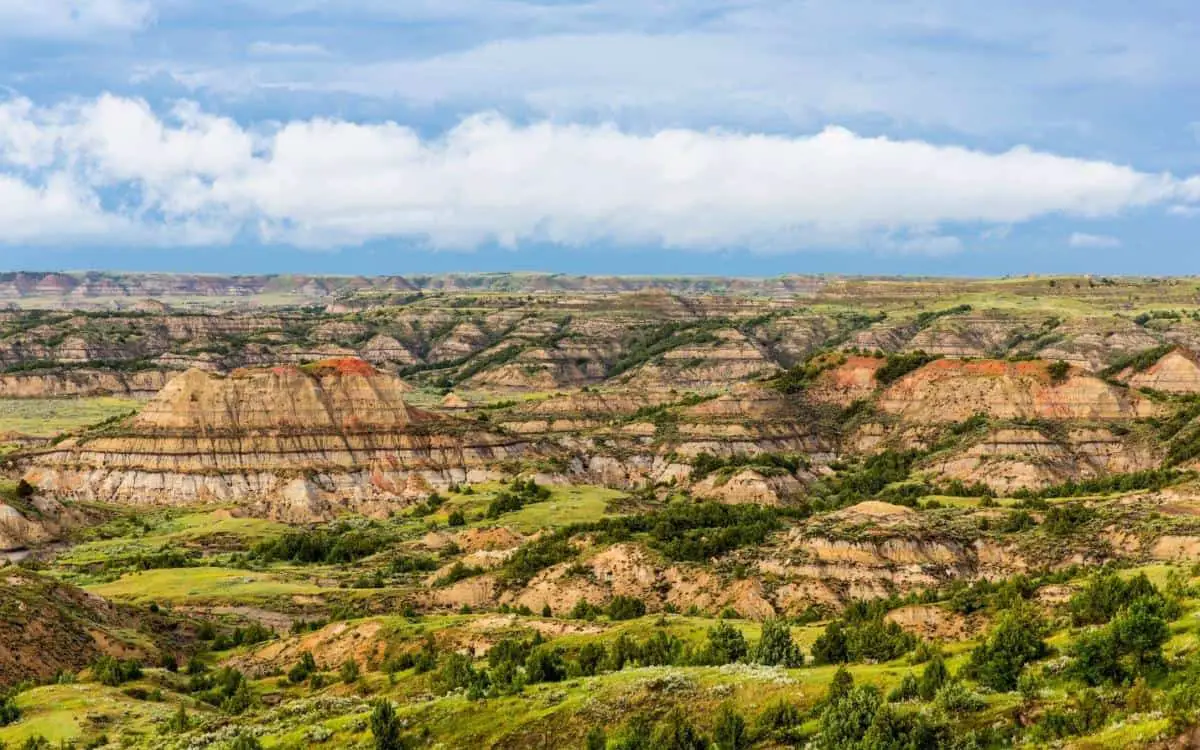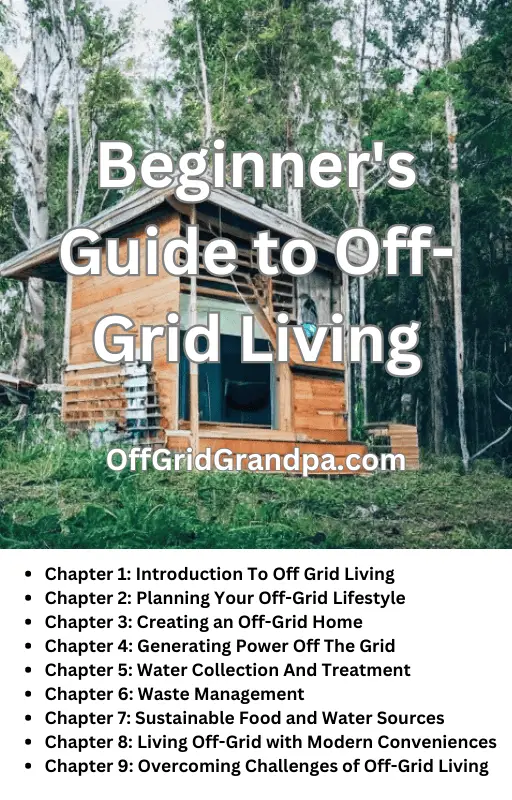North Dakota is a beautiful state if you love nature, although this beauty comes with a price, mainly harsh winters, and a fairly isolated life if you chose to live off the grid. The population in North Dakota is only around 760k people, and it only has one big city, Fargo which a population of over 100k. Only 9 more cities have a population of over 10k, and yes you have read it right, Bismarck with 72k, Grand Forks with 53k, Minot with 48k, West Fargo with 35k, Williston with 27k, Dickinson with 23k, Mandan with 22k, and Jamestown with 16k population.
Living off the grid in North Dakota is legal, the state actually facilitates living off the grid with generous rebates and incentives regarding solar and wind power systems. The cost of living is around 10% lower and the price of land is around 12% lower than the national average. On the other hand, the cold winters might be a challenge for people living off the grid when it snows it snows a lot, and you might be stuck in your homestead for a couple of days.
If you want to live off the grid in North Dakota then your biggest problem will be heating during the winter time, my personal recommendation is to use a space heater as a backup Click here to check it out on Amazon.com
Although the population of North Dakota is fairly small, during the past decade it has started to grow fairly fast, in 2009 the population was only around 645k people and today it is at 760k people, which is an over 20% increase in the last 10 years or so. Due to the state’s large size, most of the population lives in smaller communities, and there are plenty of people living off the grid in this state, and a lot of people actually move to this state from the southern parts of the country to escape the heat but find themselves in a massive freezer.
North Dakota can be a paradise for some off gridders, the reason why I am saying that it can be a paradise only for some off gridders is that the climate is extremely harsh, especially during the wintertime. As the local communities are fairly spread out, the local authorities have difficulty cleaning the roads from snow, and when it snows in North Dakota it really snows. The general complaint of North Dakota is that it is boring to live there, but from an off grid living perspective, this is a big bonus.
When you compare North Dakota to South Dakota there are not a lot of differences, except for the climate and your ability to grow crops. In South Dakota, you will have a lot easier time growing crops than in North Dakota, and the cost of living is almost the same for both of them. On the other hand, North Dakota is a hunter’s paradise, you will have no problem finding plenty of large and small game, if you need more information about South Dakota then check out my recent article Off grid living in South Dakota ( Easy Living? ).
Is Off Grid Living Legal In North Dakota?
Living off the grid is entirely permissible within the boundaries of North Dakota, as the state maintains a favorable stance on water rights, zoning regulations, and permit obligations, particularly when juxtaposed with other states. Nevertheless, it is important to note that North Dakota legislation does not exhibit significant progressiveness concerning the integration of innovative off-grid technologies.
North Dakota Off Grid Laws
There are no laws prohibiting you to live off the grid, there is no shortage of water so harvesting rainwater is also legal although in some areas they are regulated. Due to the sparse population and how spread out the population is in this state the generous tax exemptions, rebates, and incentives for both solar and wind power will actually help you live off the grid. A lot of people homeschool their children and you will find that the homeschooling laws are fairly relaxed.
Generating Power Off The Grid In North Dakota
- Solar power: North Dakota is not the best place to generate power with solar panels, the days are short and during the wintertime, the days can be fairly cloudy. You can apply for a federal investment tax which is at 30% of the total cost, on top of that North Dakota also offers a 5-year property tax exemption and if you generate surplus power then the utility company has to pay you for it with cash, by far this is one of the best deals overall in any state.
- Wind power: A lot of people who live off the grid in this state use both solar and wind power to generate their electricity, although wind turbines are a lot more expensive than solar panels but there are some generous incentives for wind power as well. On top of the 30% federal tax credit, the state also offers several rebates and incentives of around 20% on top of the federal tax credit, although this percentage will be different from one county to another.
North Dakota Climate
North Dakota has a humid continental climate, although the summers can be fairly short and the winters fairly long. In the northern part of the state, this climate can be even more extreme from mildly hot summers to extremely cold winters. During the summertime, the average temperature is around 77°F, and during the wintertime, the temperatures are around 0°F-40°F, although this also depends on the amount of snowfall.
Due to its geographical position, the temperature difference between day and night can be fairly high, even during the summertime. From an off grid living perspective, this means that the growing period for any crops is fairly short and the crops will actually grow fairly slowly due to the low nighttime temperatures. If you are looking for a state with a somewhat milder climate then check out my recent article Off grid living in Wisconsin ( America’s Dairyland ).
Best Crops To Grow In North Dakota
You will see plenty of farms in North Dakota, the best crops to grow here are corn, soybeans, and wheat, these are also the most grown crops in this state. In addition to this, you will also see a lot of cattle farms and farms growing other livestock. Although you might find it easier to grow crops in the southern part of the state, but honestly speaking the temperature difference isn’t that high to see any major difference. If you want to take a look at one of the neighboring states then check out my recent article Off grid living in Montana ( The Treasure State ).
Freshwater Availability In North Dakota
North Dakota gets a lot of rain and snowfall, in addition to this, it also has a couple of rivers and freshwater lakes. In most of the state, you will have no problem finding groundwater although the groundwater near animal farms might be polluted due to the runoff from these farms. Although you will have no problem with the fresh water, you might find it difficult to get fresh water during the winter if it isn’t snowing as most streams and lakes freeze over.
North Dakota Wildlife
North Dakota has a lot of wildlife, you can find anything from bison, elk, bighorn sheep, moose, grizzly bear, mule deer, white-tailed deer, turkey, to even pronghorns. In the local rivers and lakes, you will find bluegill, burbot, chinook salmon, black crappie, largemouth bass, and muskellunge. The elk can be a big problem in certain areas, although not necessarily because they are dangerous but because they can destroy property and eat your crops. You will need licenses both for hunting and fishing which you should get from the official website https://gf.nd.gov/licensing.
North Dakota Road Access
North Dakota doesn’t have the best roads in the state, the main problem is that the population is way too small and there aren’t a lot of roads. Cleaning the roads during the wintertime is also extremely difficult due to the size of the state. A lot of people who commute to work in this state will have a small survival or bug out bag with them during the wintertime, as the last thing you want is to be stuck in the middle of nowhere during a blizzard.
Most people who live off the grid in this state do use snowmobiles during the wintertime, these are relatively cheap when you buy them second hand so they will not impact your budget that much.
North Dakota Price Of Land
The price of land in North Dakota is around 12% cheaper than in the rest of the country, although the price of land for an off grid location can be 50% cheaper than in the rest of the country. A couple of decades ago land in this state was dirt cheap, although as the population has increased by around 20% in the last decade alone there has been an increase in demand for housing and thus the prices have also gone up.
North Dakota Property Tax
The property tax in North Dakota is at 1.01% which is slightly below the national average which is 1.08%, the highest property tax is in Richland County at 1.303%. Although the property tax might seem a little bit higher than some would think but remember that you can get a 5-year property tax exemption by simply installing a solar power system.
Cost Of Living In North Dakota
The cost of living is around 10% lower than the national average, generally speaking, the housing prices are around 12% cheaper, and for transportation, you will pay around 25% less. You will also pay less for groceries at around 5% and for health-related services at around 8%.
North Dakota Jobs
The biggest industries in North Dakota are the agricultural, transportation, energy, and even tourism industries. The unemployment rate is around 2.5% which is way below the national average which is at 4%. The minimum wage is $7.25 which is the same as the national average.
North Dakota Crime Rate
The crime rate in North Dakota is at 2.81 crimes per 1000 people and the national average is around 4 crimes per 1000 people. The counties with the lowest crime rate are Menoken, Arnegard, and Scranton. The counties with the highest crime rates are Devils Lake, Center, and Williston. As there are a lot of smaller communities in this state odds are that some of the crimes are not being reported, although generally speaking North Dakota is a fairly safe state.
North Dakota Natural Disasters
North Dakota has a couple of natural disasters, from tornadoes, floods, earthquakes, blizzards, and wildfires to even heatwaves. Generally, speaking floods and blizzards are more common, although wildfires can also occur but in most cases, these are due to human negligence than due to natural disasters.
Key Takeaways
- Abundant natural resources: North Dakota offers ample opportunities for off-grid living with its abundant natural resources, including ample sunlight for solar power and wind for wind turbines, making it suitable for renewable energy generation.
- Self-sufficiency and independence: Off-grid living in North Dakota allows individuals to embrace self-sufficiency and live independently, reducing reliance on traditional utilities and embracing sustainable practices.
- Challenging climate: It’s important to be prepared for the challenging climate in North Dakota, including harsh winters and potential weather extremes. Proper insulation, alternative heating sources, and adequate food and water storage are key considerations for a successful off-grid lifestyle in the state.

